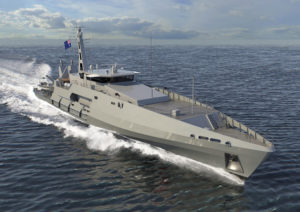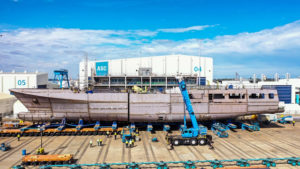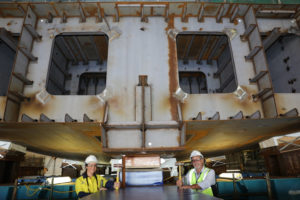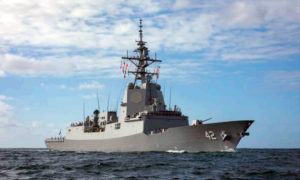This story, which was first published in the Australian Naval Architect, Volume 24 Number dated 2 May 2020 is reproduced with thanks to the Australian Division of the Royal Institution of Naval Architects.
More Patrol Boats for the RAN
The Commonwealth Government announced on 1 May that it will spend around $350 million to build six new Cape-class patrol boats for the Royal Australian Navy.
The vessels will be built by Austal in Western Australia, securing Australian shipbuilding jobs and maintaining strong border protection.
The Australian Border Force currently operates eight Cape-class patrol boats, while the Navy operates two leased vessels.
The six new Cape-class patrol boats will grow the patrol boat force to 16 vessels, while the new, larger Arafura-class offshore patrol vessels are introduced into service.
The Minister for Defence, Senator the Hon. Linda Reynolds CSC, said that the new vessels will play an important role in keeping Australia’s borders safe, while Navy’s new capability is brought online.
“These vessels will not only enhance national security, but will provide important economic stimulus and employment continuity during the COVID-19 pandemic,” Minister Reynolds said.
“The ability to build more of these vessels in Australia will deliver Australian industry content of more than 65 per cent, providing significant opportunities for Australian industry and Defence, as well as more than 1200 workers in the broader Australian supply chain.”
Austal Chief Executive Officer, David Singleton, said that the new contract both reaffirmed the Cape class as Australia’s pre-eminent patrol-boat platform and represented a clear commitment by the Australian Government to strengthen Australia’s sovereign shipbuilding industry during a challenging global environment, brought on by the COVID-19 pandemic.
“Since its introduction by the Australian Border Force (ABF) in 2013, the Cape class has proven to be a high-performing, reliable and effective maritime asset, utilised for a wide variety of constabulary and naval missions, playing a critical role in Australia’s national security,” Mr Singleton said. “With ten Capes currently in operation with the ABF and RAN, it is a smart, logical step to build upon the existing fleet with additional vessels which will enhance the nation’s ability to protect and secure our maritime borders.
“These new, evolved Capes add even greater national security at this critical time during the COVID-19 pandemic, by ensuring that at least 700 jobs are maintained at Austal, and supply chain opportunities continue for Australia’s shipbuilding industry.”

Austal is to build six evolved Cape-class patrol boats for the Royal Australian Navy (Image courtesy Austal)
Based on Austal’s proven 58 m aluminium monohull design, the new RAN evolved Capes will include a number of enhancements which further extend the capability of the vessel and the fleet. These evolved Cape-class patrol boats include modifications determined through the extensive in-service experience of the RAN and ABF Capes currently operating throughout Northern Australia.
Crew capacity has been increased by 10 people, to now total 32, and quality-of-life provisions have been enhanced, ensuring that those who operate the new Capes have connectivity to the outside world regardless of the operating environment. Further improvements have been incorporated into the new RAN Cape-class design, developed during the design and construction of two Cape-class patrol boats for the Trinidad and Tobago Coast Guard, an export contract awarded on 16 August 2019 and won with the strong support of the Australian Government and Export Finance Australia.
The Trinidad and Tobago Coast Guard Capes are currently in an advanced state of construction and are scheduled for delivery later in 2020. Construction of the six Capes for the RAN will commence immediately at Austal’s Henderson shipyard, with deliveries scheduled from September 2021, then successively through to mid-2023.
Progress with the Offshore Patrol Vessel Program
On 9 April the National Shipbuilding Program reached another milestone with the ceremonial keel laying of the second Arafura-class offshore patrol vessel (OPV) in Adelaide.
The Minister for Defence, Senator the Hon. Linda Reynolds CSC, said that the keel laying reinforced the continued progress and ongoing success story of Government’s continuous shipbuilding endeavour in Australia.
“The Arafura-class offshore patrol vessels are larger than the Armidale-class patrol boats currently in service with the Royal Australian Navy, and will offer greater endurance and capability for patrolling Australia’s maritime borders,” Minister Reynolds said.
“Over the past 10 months, Luerssen Australia and ASC Shipbuilding have contributed an enormous effort to build and commence consolidation of the keel blocks which, when complete, will be part of a 1600 t ship.
“Defence and industry are working closely together to support our sovereign shipbuilding programs and Australian jobs in these challenging times, in a way which is safe for employees and the community.”
The Minister for Defence Industry, the Hon. Melissa Price MP, said that the OPV program is creating jobs right across the supply chain.
“This project is estimated to create around 600 jobs involving more than 300 small and medium businesses, reinforcing the Morrison Government’s commitment to maximising Australian industry involvement in our $90 billion shipbuilding program,” Minister Price said.
“The project also highlights Australian industry’s ability to deliver on schedule, with construction of the first offshore patrol vessel to be built in Western Australia commencing ahead of schedule.

The forward and aft hull modules of NUSHIP Arafuracoming together at Osborne recently (Defence photograph)
The Chief of Navy, VADM Michael Noonan AO RAN, announced that the second OPV will be commissioned as HMAS Eyre when it comes into operational service in early 2023.
“The next four OPVs will be named HMAS Pilbara, HMAS Gippsland, HMAS Illawarra and HMAS Carpentaria,” VADM Noonan said.
The OPVs being built by ASC Shipbuilding at Osborne Naval Shipyard are setting the foundation of continuous shipbuilding prior to prototyping commencing on the Hunter-class frigate program this year.
Construction of the first offshore patrol vessel (OPV) to be built in Western Australia began at the end of March. The future HMAS Pilbara will be the first to be built at the Civmec shipyard in Henderson, Western Australia.
After the first two vessels built by Luerssen Australia and ASC in Adelaide, the remaining ten vessels will be constructed by Luerssen Australia and Civmec at Henderson.
Luerssen Australia is the prime contractor working with key shipbuilding partners Civmec in Western Australia and ASC OPV Shipbuilder in South Australia to deliver the OPV capability for the Royal Australian Navy.

Evyenia Kontakos, fourth-year apprentice welder and boilermaker and Larry Lavallee, Offshore Patrol Vessel Block Construction Manager, ASC Shipbuilding, after hammering in wedges to secure the Chief of Navy’s ceremonial coin in place during the keel laying ceremony of Offshore Patrol Vessel 2, NUSHIP Eyre (RAN photograph)
Last Air-warfare Destroyer Delivered
In a ceremony in Adelaide on 28 February, the Royal Australian Navy’s third air-warfare destroyer, NUSHIP Sydney, was officially handed over to Defence. NUSHIP Sydney is the last of the three ships being delivered by the Air Warfare Destroyer Alliance which includes the Department of Defence, Raytheon Australia, and ASC Shipbuilding supported by Navantia Australia.
The Minister for Defence, Senator the Hon. Linda Reynolds CSC, attended the acceptance ceremony at the Osborne Naval Shipyard in Adelaide. “Today’s milestone demonstrates the success of the Government’s Naval Shipbuilding Plan,” Minister Reynolds said.
“While the delivery of NUSHIP Sydney marks the end of this program, it represents an exciting time for the National Naval Shipbuilding Enterprise, as we continue to build upon the unique skills developed at this precinct and transfer them across the whole shipbuilding ecosystem. “I congratulate the 5000 workers who have worked directly on this program over the past decade, from the design phase through to the construction, integration and delivery of these magnificent ships.

NUSHIP Sydney entering Sydney Heads on 27 March at the end of her delivery voyage from South Australia (RAN photograph)
“The significance of this success cannot be understated and is reflected in the truly world-class capability of these warships, and the naval shipbuilding and combat system integration skills that have been developed at Osborne.”
NUSHIP Sydney arrived at her home port at Fleet Base East in Sydney on 27 March 2020 and commissioned into the RAN on 19 May 2020.
Further Reading
The Government of Australia’s Naval Shipbuilding Plan, released on 16 May 2017, outlines the Government’s vision for the Australian naval shipbuilding enterprise and the significant investment required in coming decades. It is available at https://defence.gov.au/NavalShipbuilding/Plan/
Royal Australian Navy, Arafura Class OPV, available at https://www.navy.gov.au/fleet/ships-boats-craft/future/opv
Royal Australian Navy, ADV Cape Fourcroy, available at https://www.navy.gov.au/adv-cape-fourcroy




